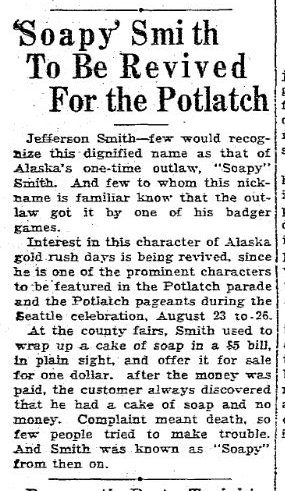apt. Jeff Smith - DECEASED
An iconic Soapy Smith artifact symbolizing the end of his life and the end of Skagway's (spelled Skaguay) reign of the bunco lawlessness.
The front side of the envelope, minus the letter and knowledge of the sender, was sent to "Capt. Jeff Smith" in June 1898 (postmark) at Skaguay, Alaska Ter. (territory). Alaska was actually not a territory, but the district of Alaska. Note that there is a stamp missing, which contained the missing date in June as well as the city of origin, however, a postmark on the rear indicates that the orgin country was Mexico. My father, John Randolph Smith (Randy) admitted that when he was a young boy he collected stamps and did remove some of the stamps from the envelops in the family collection in Mary's possession (Soapy's wife). Note that the postmaster in Skagway wrote "Deceased" at the top. At the bottom the sender wrote what appears to be "E.U.S.A." I believe I am incorrect about the "E" as it makes no sense.
The rear side of the envelope contains the very important postmarks indicating dates and locations. The letter was sent from Mexico on late June, arriving at another post office in Mexico on July 1, 1898, which means it was likely sent by someone who knew Soapy personally, perhaps a good friend. Soapy and several of the members of the Soap Gang were traveling back and forth between Mexico and the U.S. in 1895 but it is not known if any of Soapy's men were down there in 1898. The letter arrive in Seattle where it was postmarked at 7:30 a.m. on July 9, 1898, just ten hours after Soapy's violent death in the shootout on Juneau Wharf. The letter arrived and was postmarked in Skagway, Alaska six days later on July 15, 1898.
 |
(Click image to enlarge)
"There is not a man on the Denver police force who did not breath a sigh of relief when he read that “Soapy” was dead. It was bound to come, and all realized that, but the question bothering the police officials was how long “Soapy” was to go about killing other men."
—Rocky Mountain News
Alias Soapy Smith, p. 584.
OCTOBER 9
1642: The first commencement at Harvard College, in Cambridge, Massachusetts is held.
1779: John Paul Jones, commander of the American warship Bon Homme, is quoted as saying "I have not yet begun to fight!"
1780: John Andre, a British spy, is captured with papers revealing that Benedict Arnold is planning on surrendering West Point, New York, to the British.
1806: The Corps of Discovery, the Lewis and Clark expedition, arrives back to St. Louis, Missouri, ending the trip to the Pacific Northwest.
1838: Victoria Chaflin Woodhull is born. As an adult she will be the first female candidate for the U.S. Presidency.
1845: The Knickerbocker Base Ball Club of New York is formed by Alexander Joy Cartwright. It is the first baseball team in America.
1846: Astronomer Johann Gottfried Galle discovers the planet Neptune.
1862: Little Crow Indians attack Colonel Sibley's advance party at Wood Lake, Minnesota.
1869: The 8th Cavalry kill 18 Indians in a battle at Red Creek, Arizona Territory.
1872: From Fort McPherson, Nebraska, William F. Cody leads General Phil Sheridan and his party to Fort Hayes, Kansas.
1875: Outlaw, Billy the Kid is arrested for the first known time in Silver City, Arizona for stealing clothes. After two days, Billy took advantage of his small frame to squeeze his way up a chimney and escape.
1877: Nez Perce Indians raid an army depot at the Cow Island Landing, Montana Territory, killing one soldier and two civilians.
1881: Dave Rudabaugh escapes from the Las Vegas, New Mexico Territory jail and heads for Mexico.
1898: Jesse Edwards James, son of the deceased late outlaw Jesse James, is accused of leading a train robbery near Leeds, Missouri. He was tried and acquitted of charges February 28, 1899.























